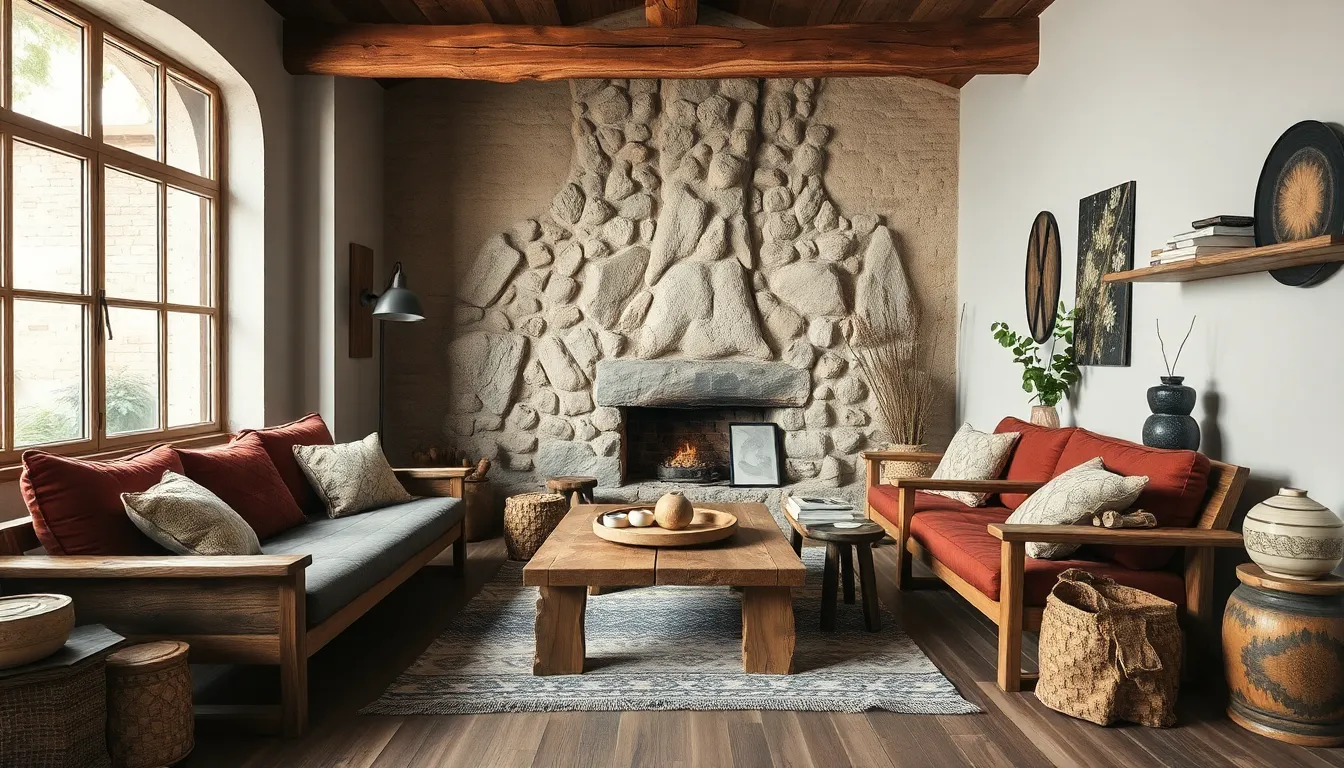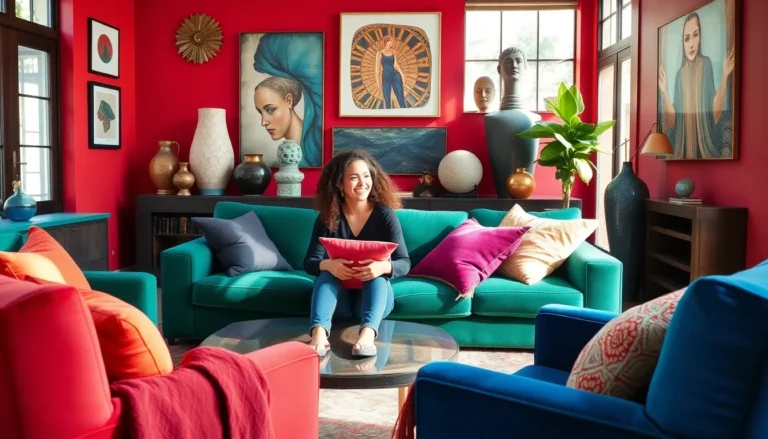Table of Contents
ToggleIn a world dominated by sleek surfaces and glossy finishes, organic textures are like a warm hug from nature. They invite you to experience the beauty of imperfection, offering a tactile feast that can transform any space. Imagine walking into a room where walls seem to breathe and furniture tells a story—that’s the magic of organic textures.
These delightful elements not only enhance aesthetics but also create a sense of harmony and comfort. Whether it’s the roughness of reclaimed wood or the soft curves of handmade pottery, organic textures bring life to design. So why settle for sterile when you can embrace the wild, wonderful world of nature-inspired decor? Dive in and discover how these textures can elevate your surroundings and maybe even your mood.
Overview of Organic Textures
Organic textures enhance interior design by introducing natural elements that contrast with artificial finishes. These textures evoke a sense of tranquility, creating inviting spaces that promote comfort and connection to the environment.
Definition and Characteristics
Organic textures refer to surface finishes inspired by nature, featuring irregularities and imperfections. Materials such as wood, stone, clay, and textiles showcase unique patterns, colors, and tactile qualities. These characteristics result in a warm, earthy aesthetic that creates visual interest. Each piece possesses individuality, ensuring that no two items are alike. Variations in grain patterns or surface finishes further emphasize the natural beauty. Textured surfaces invite touch, fostering a sense of connection to the environment.
Importance in Design
Incorporating organic textures holds substantial significance in design. They add depth and richness, transforming sterile spaces into vibrant environments. The warmth of materials like reclaimed wood promotes relaxation, making areas feel more inviting. Using these elements encourages sustainable practices, as many organic textures originate from reclaimed or responsibly sourced materials. Additionally, they foster a harmonious atmosphere, enhancing mood and well-being. Unique textures also serve as conversation starters, sparking connections among individuals in shared spaces. By embracing organic textures, designers cultivate environments that reflect a balance between nature and modern living.
Applications of Organic Textures
Organic textures find extensive use in various fields, enhancing the aesthetic and functional characteristics. Their unique qualities promote a deeper connection to nature.
Interior Design
In interior design, organic textures create inviting environments. Materials like reclaimed wood and rough stone offer warmth and visual interest. Designers often integrate these elements into walls, furniture, and flooring to establish a natural ambiance. Spaces featuring organic textures foster relaxation and comfort, appealing to both homeowners and visitors. Implementing handmade ceramics and woven textiles further enriches the sensory experience. The use of such materials transforms sterile areas into vibrant retreats, inviting individuals to feel grounded and connected.
Fashion and Textiles
Organic textures also play a vital role in the fashion industry. Designers often use natural fibers like cotton, linen, and wool. These materials not only provide comfort but also present an Earth-friendly option. Fashion collections featuring organic textures capture attention with their unique patterns and finishes. Clothing crafted from such textiles often feels softer and more breathable. Additionally, incorporating techniques like tie-dye and natural dyeing enhances visual appeal. By prioritizing organic textures, the fashion industry promotes sustainable practices while offering stylish, eco-conscious choices.
Benefits of Using Organic Textures
Organic textures enhance interior and fashion design, creating warmth and inviting spaces. They offer unique benefits that contribute to sustainable practices and aesthetic value.
Aesthetic Appeal
Natural elements create depth and visual interest in any setting. Unique characteristics found in organic materials like wood and stone give a room personality. Dimensional surfaces often draw the eye, fostering a sense of connection to nature. Handcrafted finishes add character, making spaces feel lived in and cozy. In fashion, organic fibers such as linen and wool deliver not only comfort but also sophistication. These textiles contribute to a soft, tactile experience that resonates with users, enhancing overall style.
Environmental Impact
Choosing organic textures promotes sustainability and eco-friendliness. Reclaimed wood decreases the need for new materials, helping reduce deforestation. Natural fibers, like cotton and hemp, often use fewer chemicals, resulting in less pollution. By integrating responsibly sourced materials, designers minimize their carbon footprints. Implementing organic textures in design supports local artisans, thereby boosting community economies. Incorporating such elements encourages consumers to value sustainable practices, fostering a movement toward a greener future.
Techniques to Create Organic Textures
Creating organic textures involves utilizing natural materials and embracing handmade processes. These techniques add depth and warmth to various designs, from interiors to fashion.
Natural Materials
Using natural materials remains essential in crafting organic textures. Wood, with its unique grain patterns, offers warmth and character. Stone, in its varied forms, provides visual interest and a sense of permanence. Clay serves as another excellent choice, allowing for tactile and customizable designs in pottery and ceramics. Textiles made from cotton, linen, and wool enhance comfort while promoting sustainability. Each time these materials are incorporated, they bring a piece of nature indoors, transforming spaces into harmonious environments. Selecting reclaimed wood or natural fibers reduces environmental impact, contributing to a greener planet.
Handmade Processes
Embracing handmade processes enhances the creation of organic textures. Artisans often engage in techniques like hand-weaving, pottery making, and hand-carving, ensuring that each piece bears unique qualities. Handmade items showcase irregularities that manufactured goods lack, fostering authenticity and connection. For example, hand-thrown pottery exhibits slight variations in shape and glaze. These differences contribute to individual character and charm. Incorporating handmade elements not only supports local artisans but also instills an appreciation for craftsmanship within spaces. Prioritizing these processes helps cultivate a deeper bond with the materials and the environment.
Trends in Organic Textures
Organic textures continue to evolve in various industries. Recent advancements showcase a blend of traditional craftsmanship and modern design principles.
Current Innovations
Emerging technologies enhance the application of organic textures. Designers utilize 3D printing to create intricate patterns inspired by nature. Additionally, biodegradable materials offer eco-friendly alternatives for creating textures without harming the environment. Innovations in dyeing techniques, such as natural dyes and eco-friendly processes, elevate the aesthetic possibilities of textiles, making them more appealing. Artisans showcase their work through collaboration, merging different organic materials for unique pieces. Increased customization options also allow consumers to select textures that align with their personal style, resulting in a tailored experience.
Future Projections
The future of organic textures looks promising, with trends indicating a continued emphasis on sustainability. Increased demand for eco-friendly products drives innovation in material sourcing and design practices. Designers anticipate a rise in upcycled materials, which reduce waste and promote the circular economy. Additionally, advancements in smart textiles may integrate organic textures with technology, providing functional benefits alongside aesthetic value. As consumers prioritize sustainability, more brands will incorporate organic elements into their lines. The ongoing shift toward biophilic design principles suggests organic textures will play a crucial role in creating environments that foster well-being and harmony.
Conclusion
Embracing organic textures can transform any space into a sanctuary of warmth and comfort. These materials not only enhance visual appeal but also foster a deeper connection to nature. By incorporating elements like reclaimed wood and handmade pottery, individuals can create inviting environments that promote well-being.
The shift towards sustainable practices in both interior design and fashion highlights the growing appreciation for organic textures. As designers continue to innovate with these materials, the future looks bright for eco-friendly aesthetics. Ultimately, integrating organic textures into daily life enriches spaces and nurtures a harmonious relationship with the environment.








